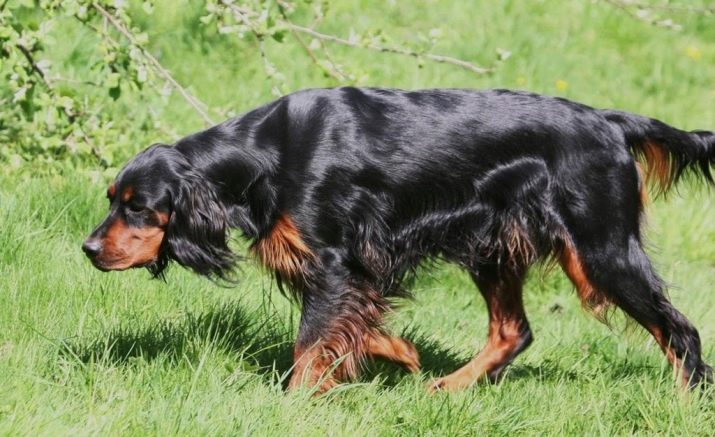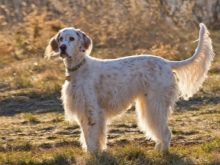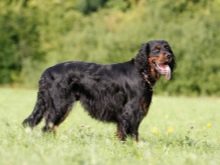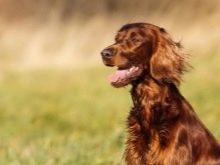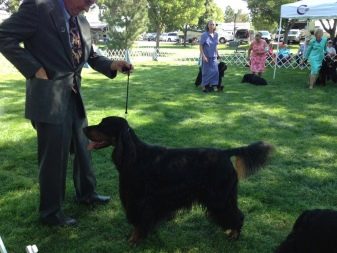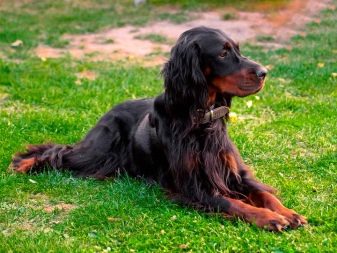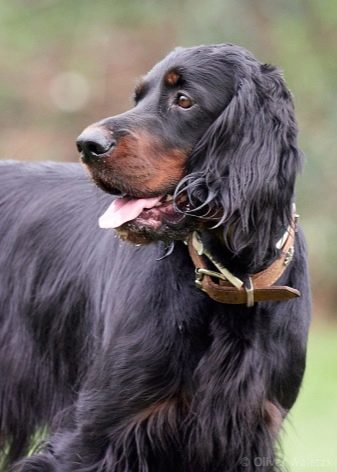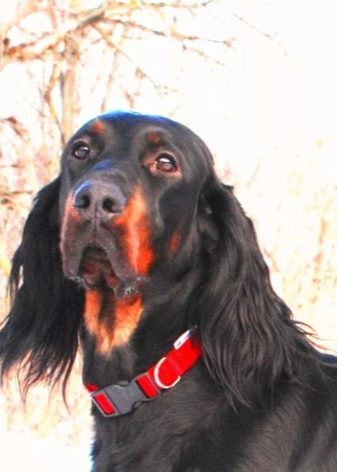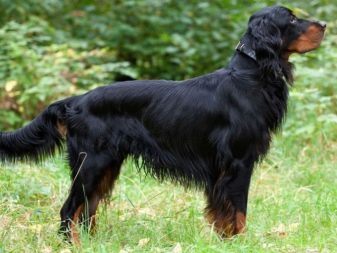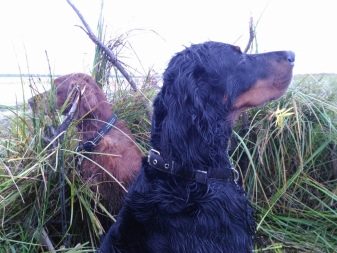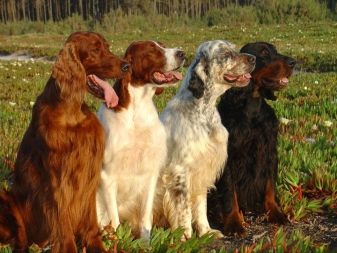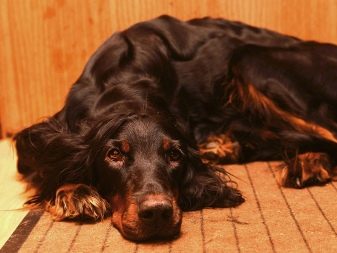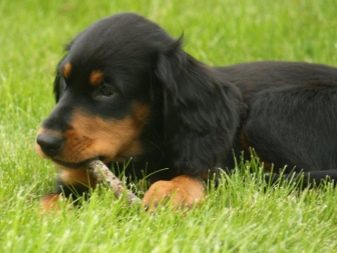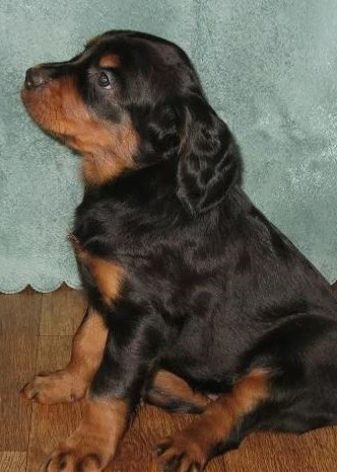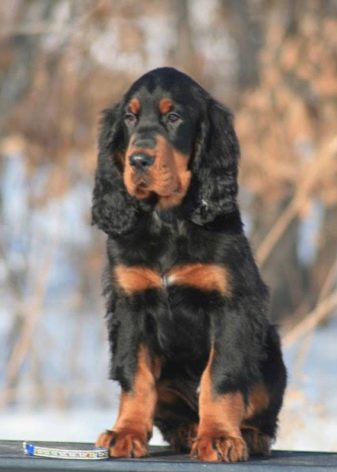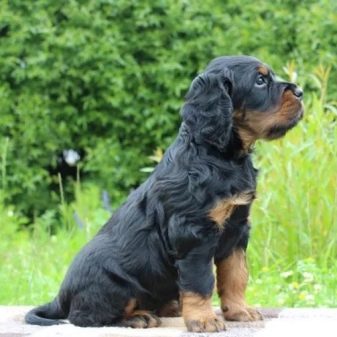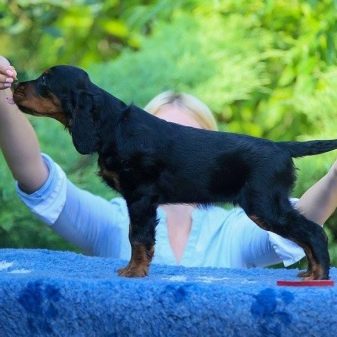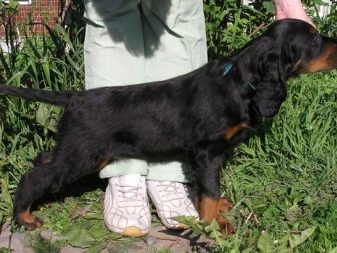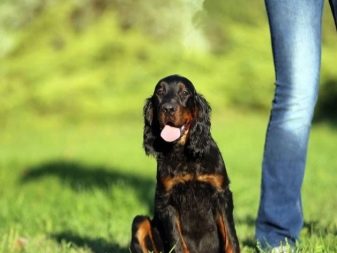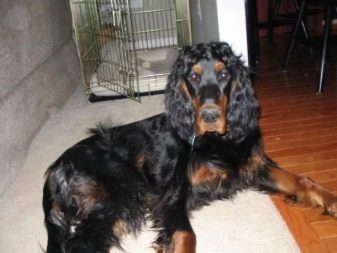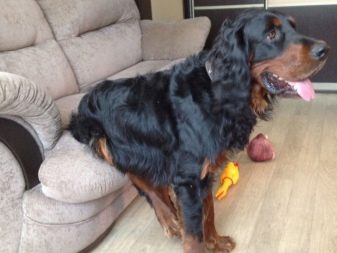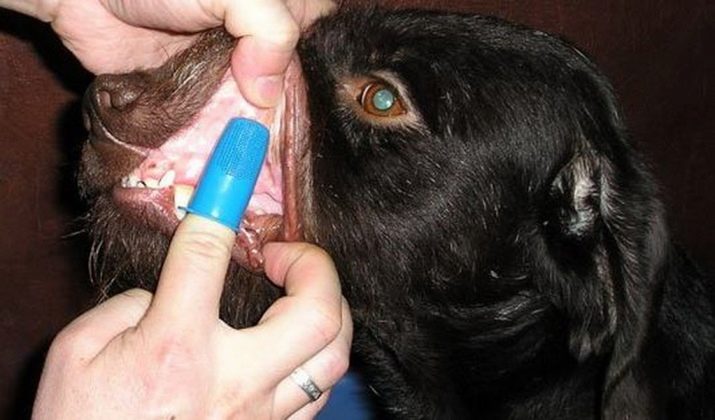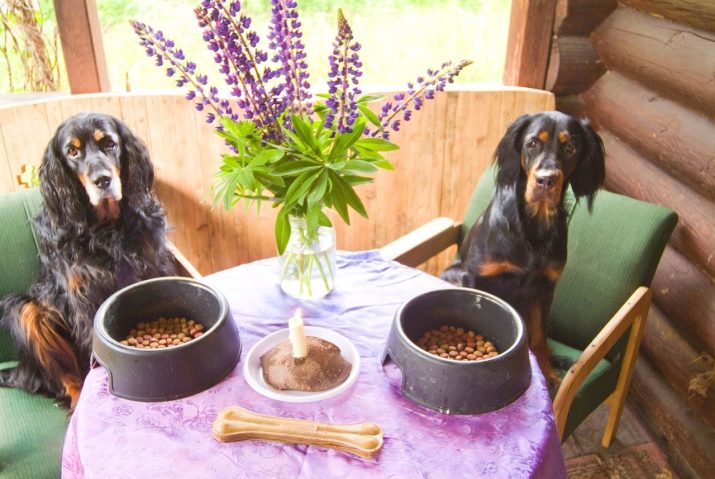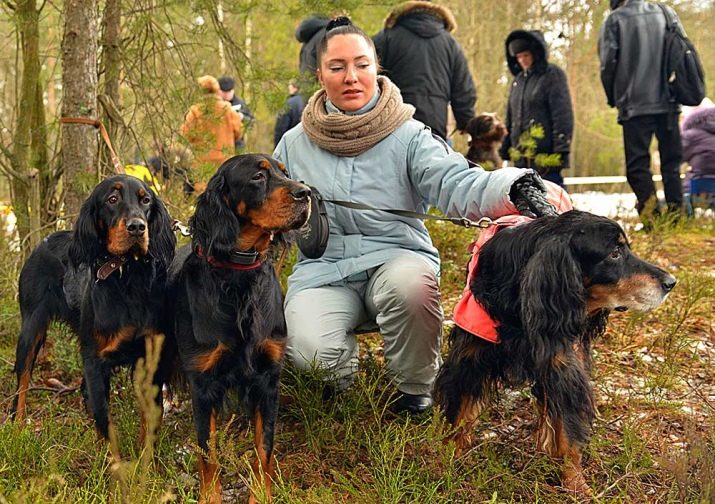Scottish Setter: the history of the breed, how it looks and how to contain it?

The Scottish Setter or Gordon is not only a very beautiful, graceful and stylish breed, it is a dog that possesses an excellent instinct. Animals are not just becoming excellent pets, but are actively used in hunting for game. In addition, representatives of the breed often become exhibitors, and if you have a desire to immerse yourself in the diverse world of dog breeding, with the Scottish setter you can do it in completely different directions.
But before you buy a dog, it is important to get acquainted with the history of its origin, to study the habits, to understand what will be the right care, and how to train.
History of origin
For the first time mention of the breed is found back in 1570, in England. However, it was definitely not the dog that we see now. In actual form, the breed was formed only by the beginning of the XIX century. Scottish setter was obtained by breeders by crossing. There are versions according to which such breeds as bloodhounds, retrievers, greyhounds, pointers are involved in the creation of the setter, some sources also refer to the poodles, the history is rich, and 100% of the data, unfortunately, are not. As a result of the selection work, three main groups of setters were formed: Irish, which is sometimes called red, English (white with splashes) and, of course, Scottish with a predominantly black color and characteristic tan.
Homeland of the Scottish Setter is considered to be the town called Fohabers, it is located in the north of the United Kingdom. It was there that lived Duke Alexander Gordon, who made the most significant contribution to the development of the breed. This variety was later named in his honor. In the castle of Gordon, there were 2 nurseries, in which dirhounds and setters were bred. The count was fascinated by the qualities of dogs and was delighted with the appearance. It was he who formed the uniform color and set the first standards. In 1882, the breed bred in Scotland was sent to America, where after another two years, it was officially recognized by the Kennel Club.
From the beginning of the 19th century, dogs began to spread in Europe and hit Russia, where avid hunters liked it. Unfortunately, after the war, the livestock has declined, and so far the breed has not had time to recover in its former abundance. Over the years, and due to the excellent qualities of the breed, the situation is changing for the better, and it pleases.
Description
Among the setters, this breed is the largest. Inside the view, the parameters vary according to gender.
- Males. On average, the height (at the withers) of an individual can reach 65 centimeters, but the weight is rather small, within the normal range the dog is considered to be 29 kg in weight.
- Bitches. Height - 62 cm, average weight - 25 kg.
In general, it is very lean and muscular variety, which is not surprising, given that it was bred for hunting. The hair is long, with a slight wave, but on the frontal part of the head and on the edges of the ears it is short. At the base of the tail, the fur is more elongated, becoming shorter as it approaches the tip. Color black and tan (chestnut color). The hollow spots are located above the eyes (at the start of the eyebrow), on the muzzle from the sides, there is a mark on the throat, two symmetrical spots should be present on the chest, also marks adorn the paws and one tan is in the area under the tail.
We give a detailed description of the setters.
- Muzzle. By proportions it is considered square, equal to the skull in length. The back of the nose is straight, the nose itself is rather wide, black, with open nostrils. The upper lip hangs over the bottom and hangs slightly. Because of this structure, the bite is called scissor, in this case, the upper teeth overlap the lower teeth.
- Eyes can be called small, planted widely. Because of the lowered upper eyelid, the look may seem sad. The color of the iris is dark brown.
- Ears. Elongated, wide, but thin. Begin at eye level and hang down beyond the muzzle, while adjacent to the head.
- Body Muscular, lean. Withers expressed. The neck is rather long, but not thin. Thorax wide, lowered in the downward direction. Belly tucked up.
- Limbs. Straight, sinewy, rather wide apart. The paws themselves are rounded.
Gordon puppies quickly acquire color and proportions similar to adults, so even at a young age you can distinguish a purebred dog from a puppy of mixed origin.
Character
In general, temper is described as calm, affectionate, playful and friendly. Of course, in each breed there are dogs with temperament, but, in addition to natural data, training should also act, so any setter can be appropriately brought up. Other dogs and animals are generally friendly and calm. If you are worried, if several different pets can get along in the same space, you should not. Setter will find a common language with the existing beast, even if it is a small and fearful animal.
The qualities with a minus sign in this breed include stubbornness. If you do not start education in time, you can miss the moment, and the animal will never want to learn manners and rules of behavior.
Another point to which you should pay attention is that they have a dominant position in the pack of dogs, therefore fights can arise among the four-legged companies in the company, especially in the men. Gordons get along well with children, they are attached to all family members, without exception, but at the same time they treat with distrust to strangers. They will not attack if a stranger approaches, but may raise an alarm when invading their territory. For this breed, communication with the host is very important, so they endure a long separation hard. If you often go on business trips, and you do not have the opportunity to take a pet with you, it is better to choose another breed so that the dog does not suffer. For the harmonious development of the pet will need to give significant mental and physical stress. This is especially important during the period of active growth of the puppy.
Features of education and training
Consider the option in which the dog appears in your home, being a puppy. After all, if you get an adult, most likely, its character is already formed, and you cannot change it muchwill have to take a new family member the way it is. The first thing you should do when a puppy appears in your home is to introduce him to his surroundings. Introduce him not only all the important family members, but also show the room. Initially, set standards - what you can and cannot do. In the future, strictly adhere to these rules without any exceptions.
Begin to engage in training, that is, the direct study of teams can be on reaching the puppy age of 5-6 months. Most commonly, the common method of carrots and sticks is used for mustering, and there should be more gingerbread in the case of setters than whips. Basic verbal commands can be accompanied by a whistle or gestures, since these dogs are very attentive to the actions of the owner and can later be more willing to execute commands presented in the form of a gesture than verbal orders.
Starting to exercise with a puppy is worth it before he was full, and after he runs a little and copes with basic needs.Each owner determines the duration of the lesson on his / her own: watch out for the dog’s interest, and try not to make it engage through force. Be attentive to behavior, dogs are eloquent in their own way.
It is not recommended to start exploring a new team if you have not completed the previous one well. Secure the material and achieve its mastery before mastering new tricks. It is important to hone skills not only in the house (even if you do it on your own open and spacious lawn), but also in nature, in a previously unfamiliar environment. Arrange periodic raids, but keep your pet in check.
When can I go to the field?
Until the setter clearly understands and executes commands such as “Near”, “Stand”, “Place”, “Cannot”, “Forward” and “Lie”, it is better not to go to large open spaces, especially without leash Further natasku should be carried out in stages, and it is better to entrust this process to a professional if you are not confident in your own strengths and methods:
- weaning from the chase;
- study of dog exposure;
- correct execution of commands at a distance;
- training for the suspender and stand;
- habituation to the shuttle search;
- practicing the feed command;
- instilling calm behavior while shooting.
Conditions for content
Let's start with the most important - no chains and closed small enclosures. Setters love freedom, and they need room for good health and sufficient activity. If you plan to keep the dog in a fenced area, then it should be divided, and the perimeter is better to lay tiles or concrete, so that the pet could not make a dig. It is not necessary to have a private country house to get such a dog. Gordons are perfectly adapted for living in an apartment. The main thing is that the animal had the opportunity to be active. I mean not only walking, but also the availability of free space in the apartment.
Activities should be given special attention, this is one of the main conditions for a good quality of life for such dogs. At least once a week you should have a chance to go out of town or walk your dog in a large park. You can combine walking the animal and your own sports, such as jogging or cycling, scooter or skateboard. Daily distances from 3 to 10 kilometers with a gradual increase in distances will be a great way to walk.
Another feature of the content is wool. It is rather long and will require washing, frequent combing and cutting. Learn how to do it yourself or find out in advance the master, with whom the dog and you will be able to build further work. If you have a show dog, one of the main rules is that a show participant should not live on the street. Due to weather conditions, the dog will change the constitution of the coat, that is, there will be an undercoat, and this will affect the appearance.
Pet comb should be comb with rare teeth. To prevent the formation of tufts and clumps of felted wool, the frequency of combing should not be less than once every 2 days. Do not overdo it with bathing. It is recommended to wash regular dogs once in 30 days, and show samples every 7-10 days. In no case should we forget about special care shampoos and balms, so as not to overdry the skin due to frequent washing. And also do not forget about oil. Which ones to choose - ask the breeder, trainer or veterinarian.
In addition to wool, it is important to care for your teeth and ears. It is recommended to do the cleaning at least once a week. Pay attention to the eyes, remove the formation in time. Claws also need care. If you do not trim them in time, the pet will get tired of walking faster and the risk of injury will increase during training and at home. In 3-4 weeks the claws will grow and will need correction, consider this.
What to feed?
If you decide to have a dog, remember, it will bring you not only a lot of joy, but also literally eat a certain part of your income. The owner determines how to build a balanced diet. Will it be a natural food, or will you try to use ready-made feed. In any case, the program is better to think in advance. An important point that you should be aware of is nutrition in the winter and during active physical exertion (for example, during the hunting season). In this case, the caloric intake is increased by 2-3 times compared with the usual diet.
There is nothing difficult in the choice of feed. Gordon is perfect food for large dogs. Adjustment will occur only in accordance with the weight and age of the dog.
Care rules
In general, this breed is quite strong, hardy and not too whimsical, but, unfortunately, like other dogs, bred by breeding, they have their most frequent diseases, about which a good owner is better known in advance. Genetic diseases that may affect your pet:
- cataract;
- hip dysplasia;
- retinal atrophy;
- hypothyroidism;
- possible torsion of the stomach (due to the nature of the chest).
Prevention of these diseases will be timely vaccination, treatment of parasites and, of course, periodic and systematic observation at the veterinarian. During hunting, such dogs can get microtraumas (cuts, sprains, bruises). It is better to pay attention to this, especially if the wounds are bleeding or have begun to fester. After each hike, carefully inspect the dog for injuries. In general, setters are wonderful pets. Their life expectancy is from 10 to 13 years, and every day spent with such a pet will be beautiful and joyful. This is a great dog that is suitable for a family with small children, and for serious hunting work. This is a beautiful, intelligent, friendly and very sensitive breed that any host can be proud of.
Do not doubt that the dog will love you with all your heart, and be sure to reciprocate it.
To learn how to properly train a Scottish setter, see the following video.
